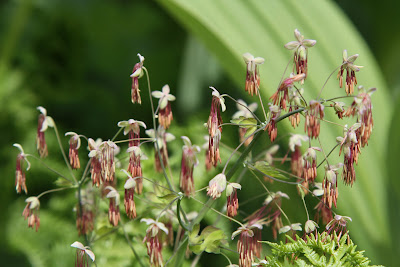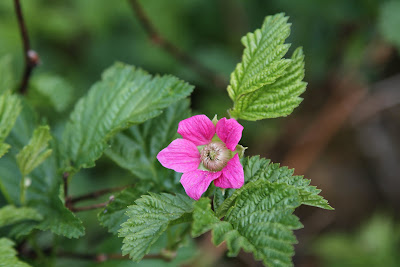
Today we hiked to Goat Lake. We started from the parking lot off of Mountain Loop Highway (location). We took the lower Elliot loop up and the upper loop back (a road called NF-4080 that is no longer passable by vehicle). The round-trip for us was about 11.5 miles and it took us about 6 hours. We sat and ate lunch at Goat Lake and explored for about an hour. It was one of the only hikes in the area that was clear of snow or so they told us at the Verlot Ranger Station. (Can we just say that in a sea of really bad architecture in that area, the Verlot station is positively cute?)
One thing that really stood out for us on this hike was the different types of flora we saw during the hike and so we’ll make a mention of a few things that we saw and could reasonably identify.
On a Mass of Snow Looking Toward Foggy Peak
Alnus rubra (Red Alder)
Have a symbiotic relationship with the bacteria Frankia that fixes nitrogen and gives a little to the tree and eventually the land – a good thing in nitrogen-deficient soils.
Alnus viridis (Green Alder)
Shrubby cousin to rubra.
Oplopanax horridus (Devil’s Club)
Panax is the genus name for ginseng, a relative to the Devil’s Club. Panax mean “all-heal” in Greek and oplo is the Greek word for weapon. So Devil’s Club is a horrible weapon that heals?
Veratrum viride (Indian Hellebore)
Vera “true” + atrum “black” refers to the plant’s dark rhizomes or flowers and viride means green, and the plant is quite green.
Valeriana sitchensis (Sitka Valerian)
We are going to have to go with the Jepson Manual etymology: Valeriana from the Latin for strength for its use in folk medicine or after Valerian, a Roman Emperor.
Thalictrum occidentale (Western Meadow-rue)
Thalictrum is name given by the Greek physician-botanist Dioscorides (circa 40-90 AD), author of Materia Medica a key pharmacological text for sixteen centuries. One source suggests that he derived the word from ‘thaliktron’ which mean a plant with divided leaves. And just when you think you can leave it at that, somewhere, in some corner of the internet you find Medica available (translated naturally) and you feel compelled to check. In Book Four: Other Herbs & Roots, there is a reference to THALIKTRON but there isn’t a clue to why the name was chosen.
Trillium ovatum (Western Trillium)
Always a pleasant site to see.
Aquilegia formosa (Red Columbine)
The genus Aquilegia name derives from the Latin word ‘aquila’ (eagle) referring to the shape of the flower petals (sepals in this case). Formosa is handsome and that it is.
Rubus spectablis (Salmonberry)
The wild cousin of the familiar raspberry. The genus name rubus is said to derive from the Latin word ‘ruber’ meaning red. For the berries or the blood drawn as you try to forage the brambles?
Lysichiton americanum (Western Skunk Cabbage)
Some of the biggest and stateliest leaves you find in Western Forests. Lysichiton derives from the Greek ‘lysis’ (meaning “a loosening or releasing”) of the ‘chiton’ (meaning “tunic, cloak or cover”) that is the spathe-like bract. [ref].

No comments:
Post a Comment
All comments go through a moderation process. Even though it may not look like the comment was accepted, it probably was. Check back in a day if you asked a question. Thanks!